

| Salticidae - Jumping spiders in Nottinghamshire | ||
| The Salticidae
are without doubt, the most appealing of spider families
and their charming and charismatic nature, make them a
natural favourite for photographers. Their often small size and frequent variation in markings, do make them a little tricky to identify, but several species are very distinctive and easy to determine. This page includes photographs of some of the more commoner Nottinghamshire species we have photographed to date. As with many invertebrates, it's also possible not to have to leave home to find at least one species of jumping spider, with the commonly known Zebra Spider (Salticus scenicus) being present on walls and fences of most houses and buildings on warm, sunny days. |
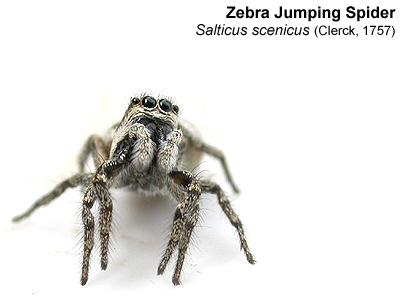 |
|
| ...... | ||
| At our own
home in Market Warsop, we have recorded Pseudeuophrys
lanigera, Salticus scenicus and Sitticus
pubescens. These three are also sometimes
encountered indoors, after entering through open windows
and are perhaps the most likely species to be encountered
on many people's properties. Salticidae spiders are renowned for their acute eyesight, with four sets of eyes including the anterior medians (1) the anterior laterals (2) the posterior medians (3) and finally the posterior laterals (4). The anterior median eyes of Salticidae spiders, are actually capable of more degrees of movement than human eyes, are able to focus and have binocular vision. They can probably also detect colour, as the males of some species (notably Euophrys frontalis in Nottinghamshire) use colour and markings in their courtship of the female. Two pairs of eyes towards the rear and on top of the head, pick up movement and the spider turns to have a better look using the anterior median eyes. The position of all eight eyes, enables Salticidae spiders to have 360 degree vision. |
||
| ...... | ||
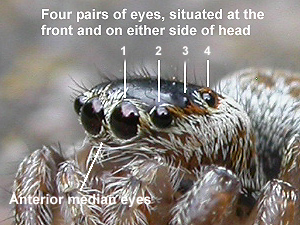 |
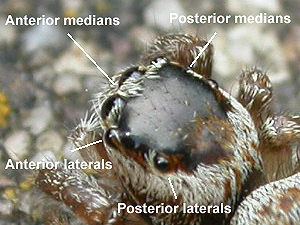 |
Because these spiders
turn towards you when being photographed, or attempting
capture (sometimes even raising themselves up) they
appear to show a fearless attitude far greater than their
small size. They are excellent hunters and they can take prey virtually their own size quite easily, as illustrated by the Salticus scenicus capturing the juvenile Amaurobius fenestralis in the photograph below. |
| ...... | ||
| When hunting,
once the spider has spotted a prey item, it gradually
moves closer until it is with jumping range (usually a
few centimetres) and when these spiders attack, the prey
is grabbed by the spider's forelegs. Jumping spiders are
not the only group of spiders that can jump. Wolf Spiders
(Lycosidae) are just one other group that can
also jump and are able to jump whilst moving, whilst Salticidae
only jump from a standing position. Salticidae in Nottinghamshire and the UK The UK has records of 36 species of Salticidae of which 13 species are currently known from VC56 Nottinghamshire. Many UK Salticidae are restricted to coastal areas and southern counties of the UK, but appearances away from these areas could coincide with likely changes to the UK's climate. Because the study and identification of spiders is less practiced in Nottinghamshire than most other invertebrate groups, there is the possibility that more species will eventually be added to the Nottinghamshire list. Two such examples occurred in 2023, with the first county records of Marpissa muscosa and Sibianor larae from a single north Nottinghamshire site, with both records of being of local and national notability. |
||
| ...... |
| Nottinghamshire Salticidae species list |
| EUOPHRYS C.L. Koch, 1850 |
| Euophrys frontalis (Walckenaer, 1802) |
| ...... |
| EVARCHA Simon, 1902 |
| Evarcha falcata (Clerck, 1757) |
| ...... |
| HELIOPHANUS C.L. Koch, 1833 |
| Heliophanus cupreus (Walckenaer, 1802) |
| Heliophanus flavipes (Hahn, 1832) |
| ...... |
| HYPOSITTICUS Lohmander, 1944 |
| Hypositticus pubescens (Fabricius, 1775) |
| ...... |
| MARPISSA C.L. Koch, 1846 |
| Marpissa muscosa (Clerck, 1757) |
| ...... |
| NEON Simon, 1876 |
| Neon reticulatus (Blackwall, 1853) |
| ...... |
| PSEUDEUOPHRYS Dahl, 1902 |
| Pseudeuophrys lanigera (Simon, 1871) |
| ...... |
| SALTICUS Latreille, 1804 |
| Salticus cingulatus (Panzer, 1797) |
| Salticus scenicus (Clerck, 1757) |
| ...... |
| SIBIANOR Logunov, 2001 |
| Sibianor larae Logunov, 2001 |
| ...... |
| SYNAGELES Simon, 1876 |
| Synageles venator (Lucas, 1836) |
| ...... |
| TALAVERA Peckham & Peckham, 1909 |
| Talavera aequipes (O.P.-Cambridge, 1871) |
| ...... |
| Euophrys frontalis (Walckenaer, 1802) |
|||
| A small jumping spider which is found in open wooded areas and probably heathland. It can often be found under stones, but this one was one of two which were found underneath a reptile rufugia at Sherwood Forest CP in April 2010. Euophrys frontalis is an attractive little spider, whose small size makes it quite indistinctive to the eye. The more colourful male (left photograph) and female (right photograph) are illustrated. | |||
| .... | |||
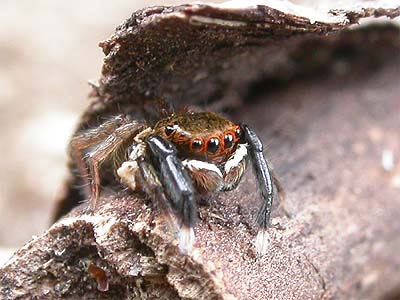 |
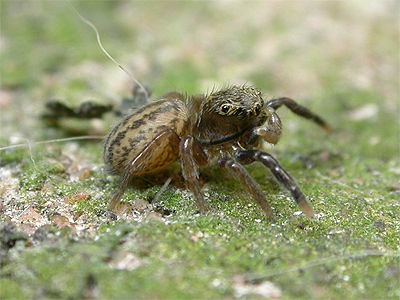 |
||
| Evarcha falcata (Clerck, 1757) |
|||
| A small and common jumping spider found in woods, but also relatively open places such as heathland and disused pit tops. This male (lower two photographs) and female Evarcha falcata, were both found on low vegetation among trees on a south-facing bank at Warsop Main Pit Top in late April 2010. The colouration and markings of the male (below right) seem relatively consistant, but the female (below left) is more variable. | |||
| .... | |||
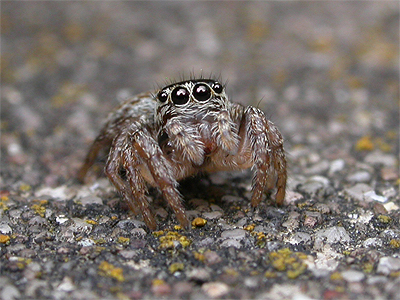 |
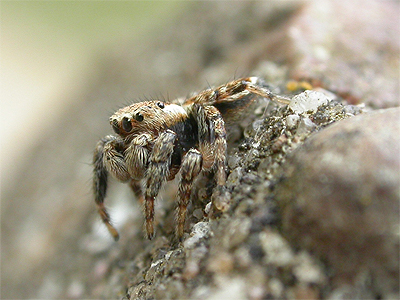 |
||
| Heliophanus cupreus (Walckenaer, 1802) |
||
| A relatively common spider across southern parts of the UK, which usually favours dry, sunny habitats. Heliophanus cupreus is virtually identical to the more common Heliophanus flavipes and specimens should ideally be checked to determine identification. The lack of general interest in Arachnids, means that there are typically few county records and in Nottinghamshire, it is currently restricted to just two sites. | ||
| .... | ||
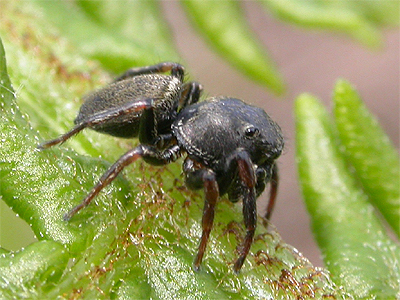 |
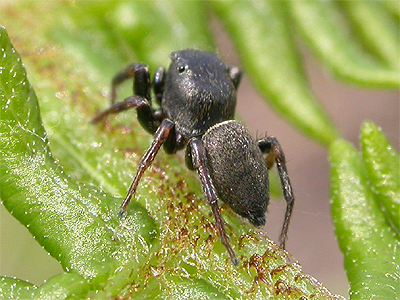 |
|
| Heliophanus flavipes (Hahn, 1832) |
|||
| A common spider, found in a variety of open, dry habitats. This is a small species measuring around 5mm in length. The ones photographed, were found at Budby South Forest and Warsop Main Pit Top in late March 2010. | |||
| .... | |||
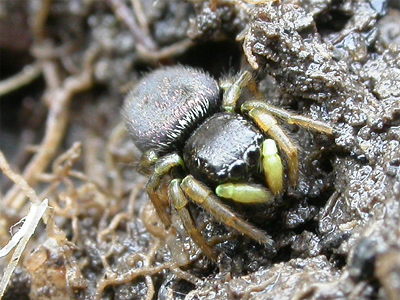 |
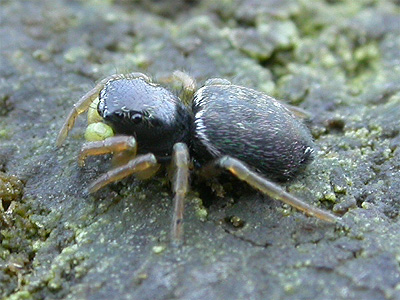 |
||
| Hypositticus pubescens (Fabricius, 1775) |
|||
| Hypositticus pubescens (formerly Sitticus pubescens) is often found around houses, walls and roofs etc, only occasionally in more rural locations. It has recently (March 2023) been found in numbers at Dukes Wood near Eakring. Widespread, but quite locally distributed across much of the UK. | |||
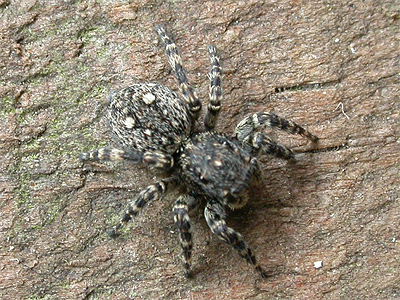 |
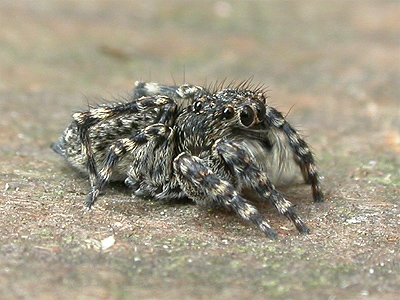 |
||
| Marpissa muscosa (Clerck, 1757) |
|||
| Found new to Nottinghamshire in 2023, when two specimens were found on fences at the Nottinghamshire Wildlife Trust's Misson Carr NR in September by Nick and Samantha Brownley, who very kindly provided the photographs illustrating the spider below. Largely a south-easterly species in the UK, though has been reported to be moving northwards. | |||
| .... | |||
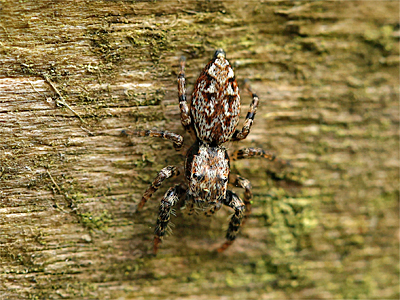 |
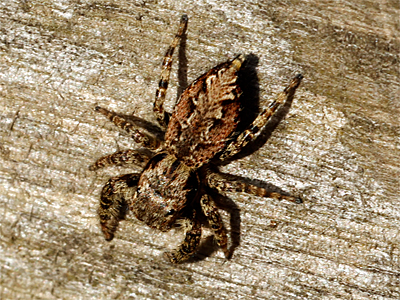 |
||
| Neon reticulatus (Blackwall, 1853) |
|||
| A common spider, Neon reticulatus is usually found low to the ground amongst leaf litter etc. This is a small species measuring around 5mm in length and has been found several times at Sherwood Forest CP in the past few years, but three turned up in a Pine needle/leaf litter sample from Market Warsop Cemetery in late February 2020. | |||
| .... | |||
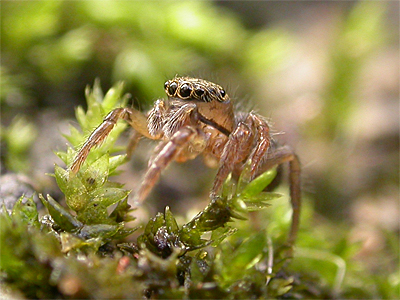 |
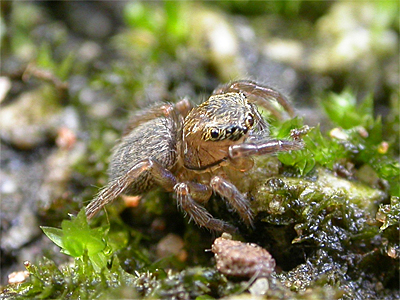 |
||
| Pseudeuophrys lanigera (Simon, 1871) |
|||
| A small, active jumping spider which is often found on houses and walls, although it can spend most of it's time high up and out of sight. Pseudeuophrys lanigera occasionally enters houses, such as this one did at Market Warsop in early October 2009. Length 4.5mm. | |||
| .... | |||
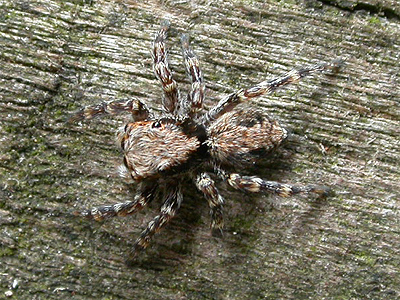 |
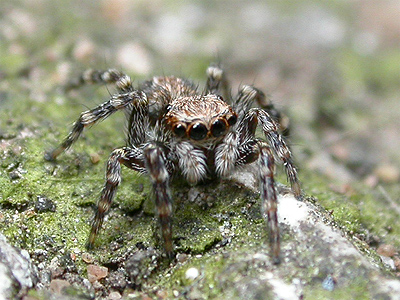 |
||
| Salticus cingulatus (Panzer, 1797) |
|||
| A small, active spider which is usually found on tree trunks and fence posts. These Salticus cingulatus females were both found on Birch at Sherwood Forest CP, where S. cingulatus seems commoner than S. scenicus. We have also recorded this spider from Eakring Meadows NR. | |||
| .... | |||
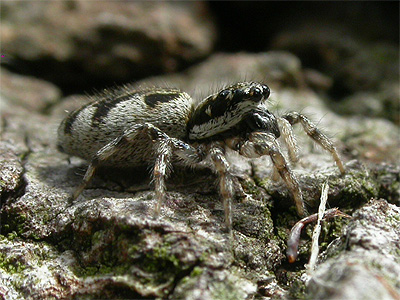 |
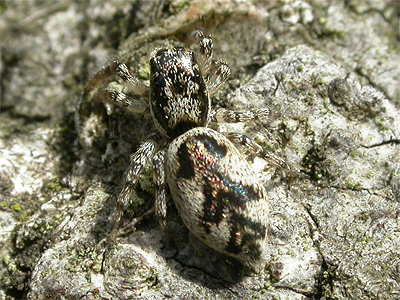 |
||
| Salticus scenicus (Clerck, 1757) |
|||
| A small, active and charismatic spider which is often called the Zebra spider. Salticus scenicus is common on the walls of houses in urban areas, but will be found in most habitats. This species is similar to the more uncommon S. cingulatus. | |||
| .... | |||
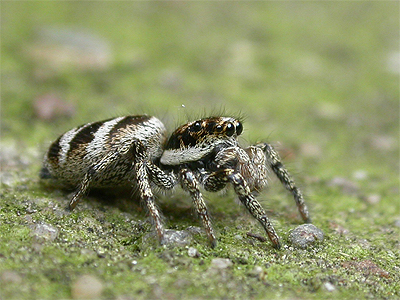 |
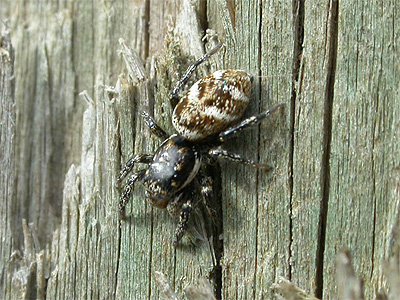 |
||
| Sibianor larae (Logunov, 2001) |
|||
| A rare species nationally in the UK and known from only a few sites in the north of the country. It was a surprising addition to the Nottinghamshire fauna in 2023, when a specimen was found by Adrian Dutton at Misson Carr. | |||
| Synageles
venator
(Lucas, 1836) |
||
| Synageles venator is a largely coastal species of southern parts of the UK. It is certainly very rare in Nottinghamshire, where it is believed to be restricted to the Nottinghamshire Wildlife Trust's Misson Carr NR and at Netherfield Lagoons. | ||
| .... | ||
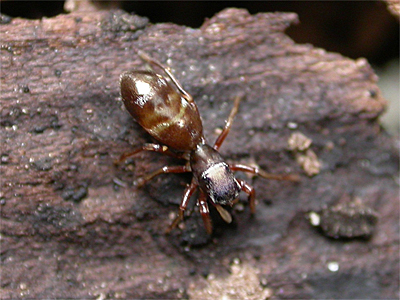 |
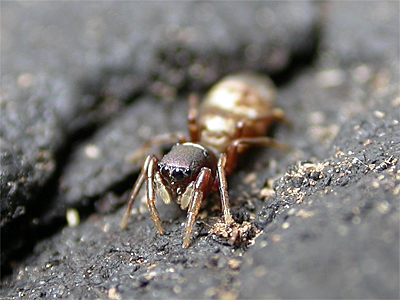 |
|
| Talavera aequipes (O.P.-Cambridge, 1871) |
|||
| The current number of just two known sites, suggests that Talavera aequipes is rare in Nottinghamshire, with records from Sherwood Forest in 1978 (BAS Survey Team) the Idle Valley NR in 2000 (Williams, H.) and most recently from Attenborough NR in 2015 (Sexton, T.). A Spider of warm, open, sunny habitats, with areas of bare ground. | |||
| .... | |||
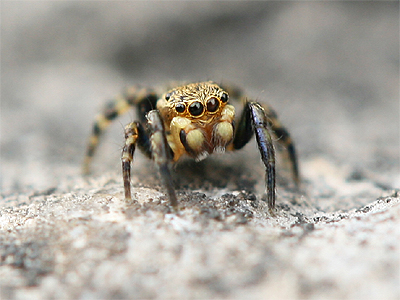 |
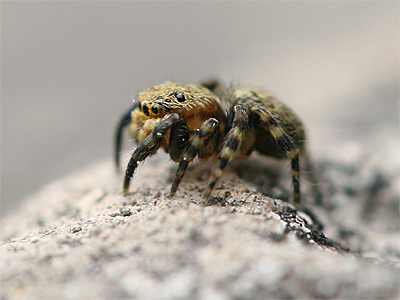 |
||
| Nottinghamshire distribution Because of the general lack of interest in Arachnids showed by many of the county's naturalists over the years, our knowledge of their distribution is often rather scant to say the least. A typical example of how little spiders are recorded, would be the distribution map for Salticus scenicus. This is a quite easily identified spider, that will be found on virtually every property in the county and it is certainly a widespread spider of urban areas. Most people will have seen it on the exterior walls of their properties, yet have never thought to report the sighting. So when looking at the following maps, consideration must be given to the fact that the maps probably show the minimal distrbution for most species. |
||
| Euophrys frontalis (Walckenaer, 1802) | Evarcha falcata (Clerck, 1757) | |
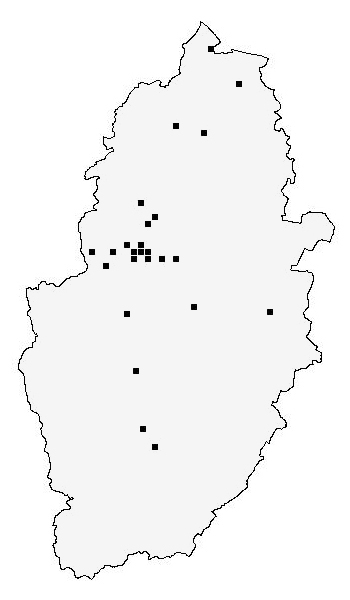 |
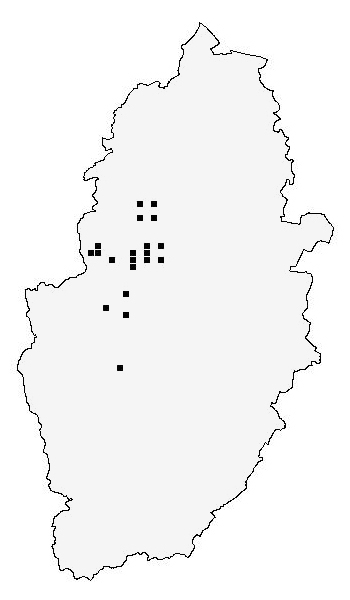 |
|
| The records for the Nottinghamshire distribution map are currently provided by the following contributors - Trevor and Dilys Pendleton. Nottinghamshire Wildlife Trust. Howard Williams. Allan and Annette Binding (Clumber Park invertebrate records). Stuart Warrington. The National Trust (Clumber Park invertebrate records). Sherwood Forest Invertebrate Directory 2014. | The records for the Nottinghamshire distribution map are currently provided by the following contributors - Trevor and Dilys Pendleton. Nottinghamshire Wildlife Trust. Andy Godfrey (2006 Sherwood Heath SSSI invertebrate survey). Sherwood Forest Invertebrate Directory 2014. Stuart Warrington. The National Trust (Clumber Park invertebrate records). | |
| Heliophanus cupreus (Walckenaer, 1802) | Heliophanus flavipes (Hahn, 1832) | |
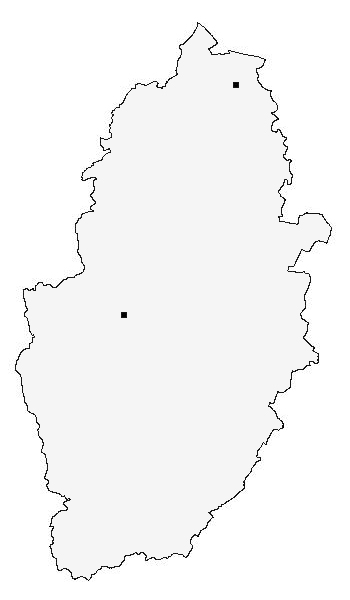 |
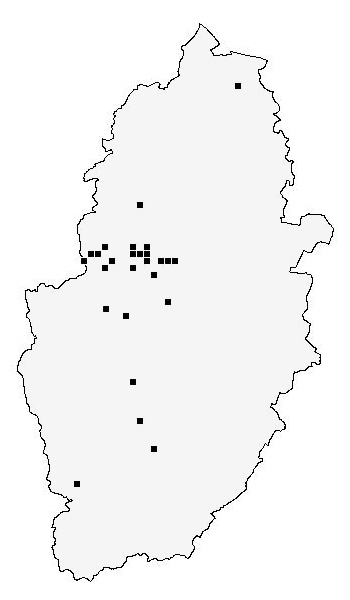 |
|
| The records for the Nottinghamshire distribution map are currently provided by the following contributors - Howard Williams. Nottinghamshire Wildlife Trust. Trevor and Dilys Pendleton. | The records for the Nottinghamshire distribution map are currently provided by the following contributors - Trevor and Dilys Pendleton. Nottinghamshire Wildlife Trust. Bob Merritt. Tim Sexton. Andy Godfrey (2006 Sherwood Heath SSSI invertebrate survey). Sherwood Forest Invertebrate Directory 2014. Stuart Warrington. The National Trust (Clumber Park invertebrate records). | |
| Hypositticus pubescens (Fabricius, 1775) | Neon reticulatus (Blackwall, 1853) | |
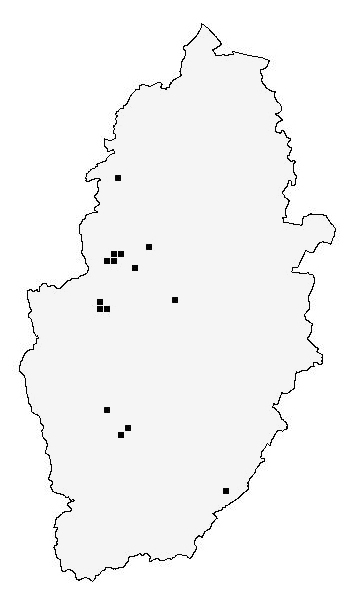 |
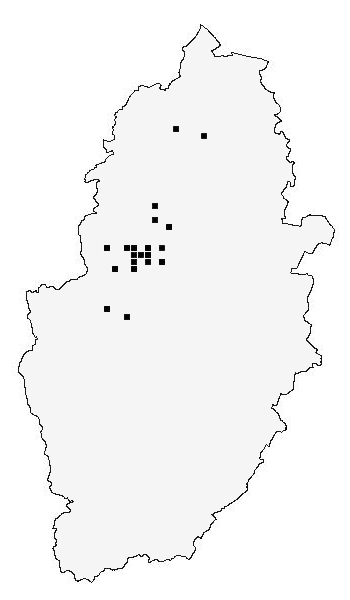 |
|
| The records for the Nottinghamshire distribution map are currently provided by the following contributors - Trevor and Dilys Pendleton. | The records for the Nottinghamshire distribution map are currently provided by the following contributors - Trevor and Dilys Pendleton. Nottinghamshire Wildlife Trust. Sherwood Forest Invertebrate Directory 2014. Stuart Warrington. The National Trust (Clumber Park invertebrate records). | |
| Pseudeuophrys lanigera (Simon, 1871) | Salticus cingulatus (Panzer, 1797) | |
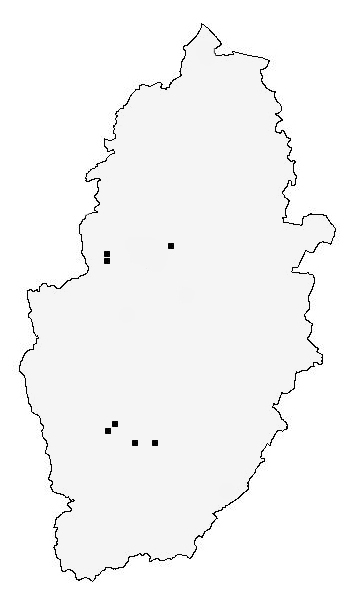 |
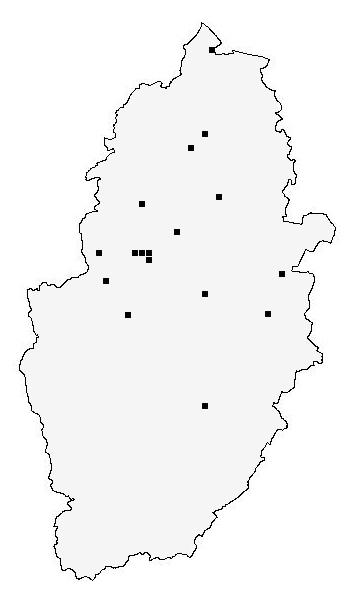 |
|
| The records for the Nottinghamshire distribution map are currently provided by the following contributors - Trevor and Dilys Pendleton. Sherwood Forest Invertebrate Directory 2014. | The records for the Nottinghamshire distribution map are currently provided by the following contributors - Trevor and Dilys Pendleton. Nottinghamshire Wildlife Trust. Howard Williams. Stuart Warrington. The National Trust (Clumber Park invertebrate records). Sherwood Forest Invertebrate Directory 2014. | |
| Salticus scenicus (Clerck, 1757) | Sibianor larae (Logunov, 2001) | |
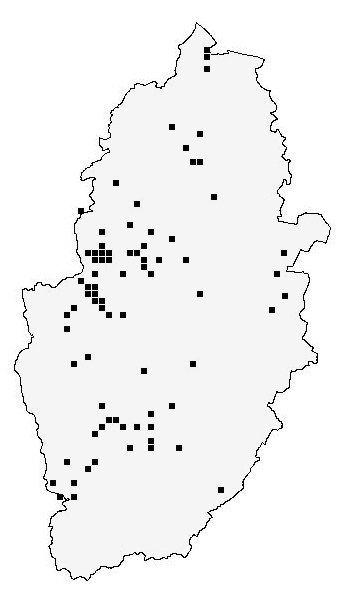 |
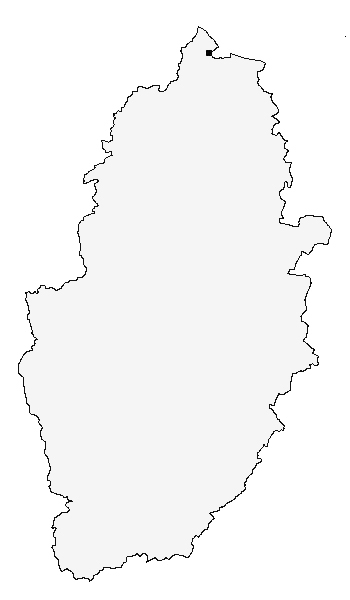 |
|
| The records for the Nottinghamshire distribution map are currently provided by the following contributors - Richard Rogers. Trevor and Dilys Pendleton. Tim Sexton. Nottinghamshire Wildlife Trust. Netherfield Wildlife Group. Stuart Warrington. The National Trust (Clumber Park invertebrate records). | The records for the Nottinghamshire distribution map are currently provided by the following contributors - Adrian Dutton. Nottinghamshire Wildlife Trust. | |
| Synageles venator (Lucas, 1836) | Talavera aequipes (O.P.-Cambridge, 1871) | |
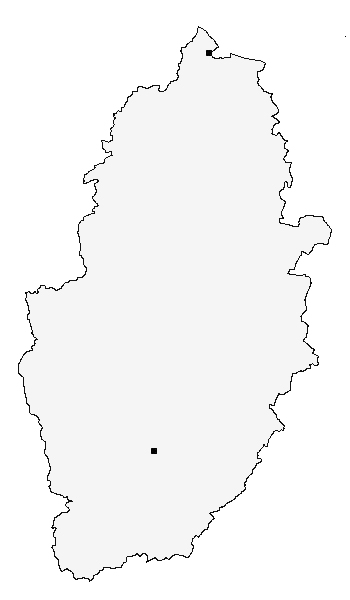 |
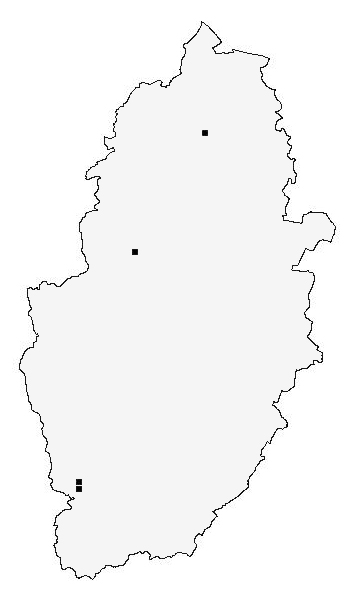 |
|
| The records for the Nottinghamshire distribution map are currently provided by the following contributors - Nottinghamshire Wildlife Trust. Howard Williams. Trevor and Dilys Pendleton. Tony Cavanagh. Netherfield Wildlife Group. | The records for the Nottinghamshire distribution map are currently provided by the following contributors - Nottinghamshire Wildlife Trust. Tim Sexton. Sherwood Forest Invertebrate Directory 2014. | |